Nasu Dengaku (Japanese Miso Glazed Eggplant)
This easy nasu dengaku recipe creates tender, caramelized eggplant glazed with a sweet and savoury miso sauce. It’s the perfect Japanese side dish. Or serve it as a main paired with steamed rice and tofu.
Nasu dengaku is a Japanese miso-glazed eggplant dish. Nasu means eggplant (or aubergine) and dengaku refers to food coated in a sweet dengaku miso sauce. You’ll often find skewered tofu or vegetables served this way.
And from all the different types of miso dengaku, eggplant dengaku is my favourite. It’s sweet, savoury and packed with umami flavour, and makes an indulgently delicious Japanese side dish.
Best of all? It’s surprisingly easy to make at home.
In the easy nasu dengaku recipe, I provide options to bake or pan-fry the eggplant before grilling it into tender, caramelised, eggplant bites – perfect for picking with your chopsticks.
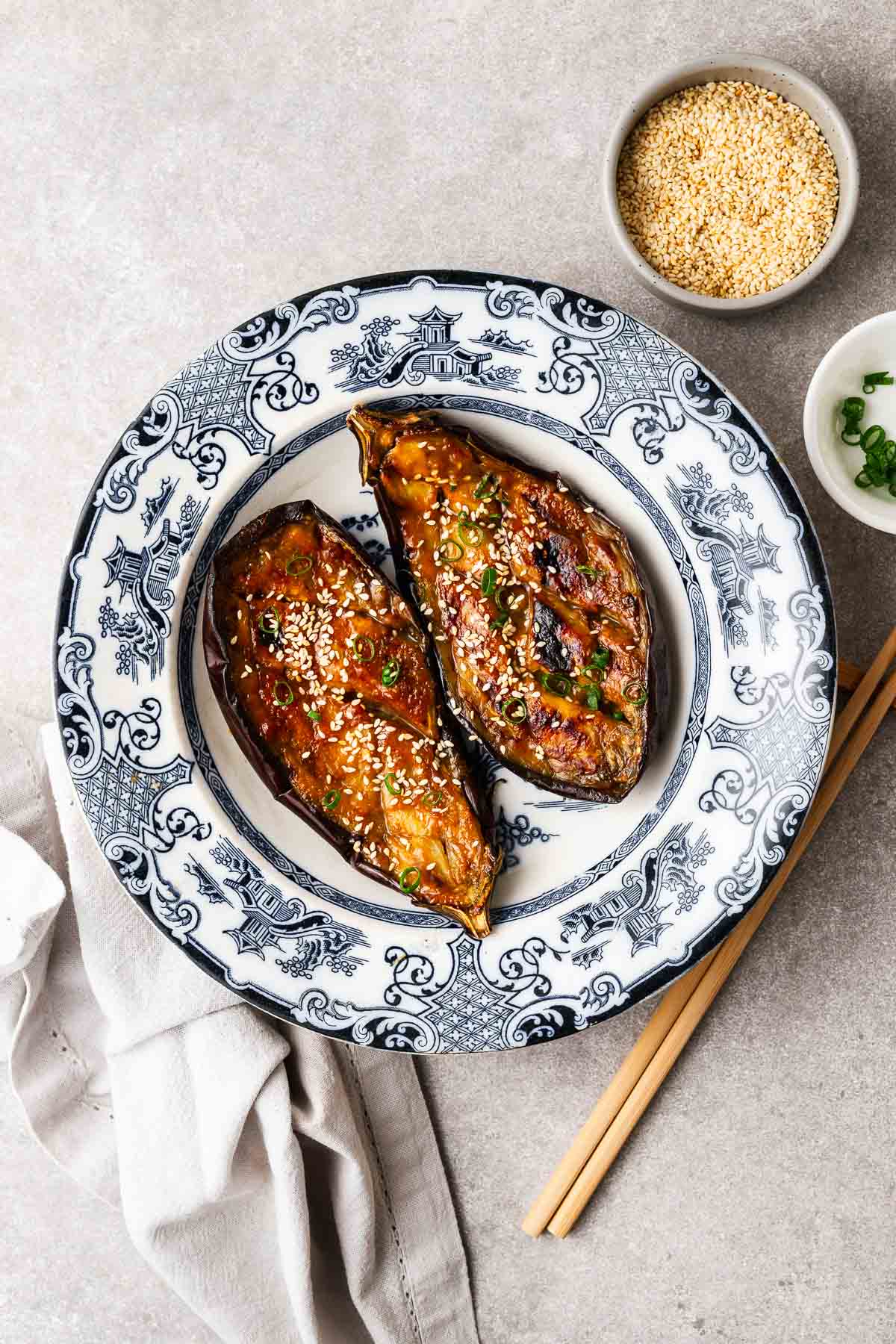
Why you’ll love miso eggplant
- It’s versatile: Serve it as a side dish or make it a main by pairing it with steamed rice and tofu. You can also add different toppings to change up the flavour.
- It’s easy to make: With two cooking methods to choose from, adjust this easy recipe to suit your mood. The recipe is also very easy to scale up for a crowd.
- It’s packed with flavour: The combination of sweet miso glaze and silky roasted eggplant creates a taste sensation that’s sure to please any crowd.
- It’s naturally vegan: The plant-based side is also easy to make gluten-free if you stick to gluten-free miso paste and tamari.
Ingredients and substitutes
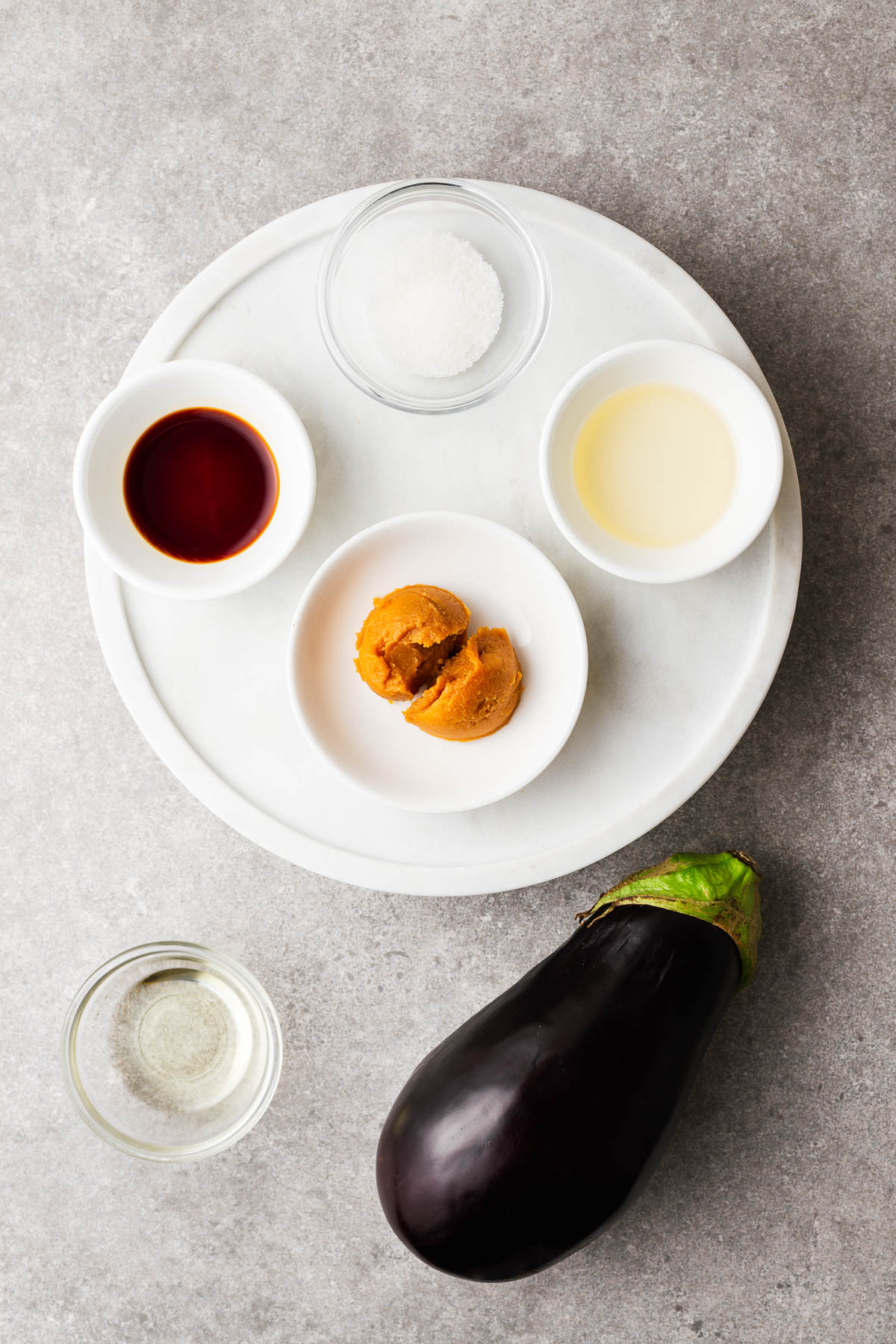
To make this delicious Japanese dish, you will need eggplant (aubergine) and a few classic Japanese pantry staples.
You should find these in any Asian grocery store, but I suggest some alternatives if you can’t:
- Eggplant (Aubergine): I use a medium to large eggplant. But you can also use Japanese eggplants if you prefer. Just reduce the cooking time if you use small eggplants.
- Vegetable oil: I use a neutral oil like vegetable or canola oil for frying the eggplant. But you can use any oil you have on hand.
- Miso paste: This fermented Japanese ingredient adds a rich and savoury flavour to the dish. I use white miso for its sweet and fruity taste, but you can also use red miso or awase miso. If you don’t have miso, try this recipe with a miso substitute.
- Sugar: A little bit of white sugar helps to balance the saltiness of the miso and adds a touch of sweetness to the dish. It also helps to create a sticky, caramelised miso glaze. You can use your preferred sweetener – it’s delicious with maple syrup too!
- Mirin: This sweet Japanese rice wine adds depth and complexity to the miso glaze. I use hon mirin (aka real mirin). If your mirin contains corn syrup or sugar, it is not “real” brewed mirin and will most likely be significantly sweeter. But that’s OK, just omit the extra sugar. Or, if you don’t have mirin, substitute it with a combination of sake and sugar (or in a pinch, mix white wine and sugar).
- Soy sauce: Soy sauce adds a salty and umami flavour to the dish – all-purpose or light soy sauce is perfect. Use tamari if you need the dish to be gluten-free.
Optional toppings
The miso eggplant dish is utterly delicious as it is, but I like to add a sprinkle of toasted sesame seeds and thinly sliced green onions.
- Sesame seeds: Toasted sesame seeds add a nutty flavour and a bit of crunchy texture to the dish. You can also use black sesame seeds or omit them altogether. See how to toast sesame seeds in a pan or oven.
- Green onions (scallions): Thinly sliced green onions add a bit of freshness and a pop of colour to the dish.
- Togarashi: You can even sprinkle the sweet eggplant with a pinch of shichimi togarashi, a spicy Japanese spice mix, for a sweet and spicy twist.
How to make nasu dengaku
There are four main steps to making Japanese miso glazed eggplant at home:
- Prepare the eggplant
- Cook the eggplant until tender (stovetop or oven)
- Make the miso mixture
- Grill the miso-glazed eggplant until caramelised
Prepare the eggplant
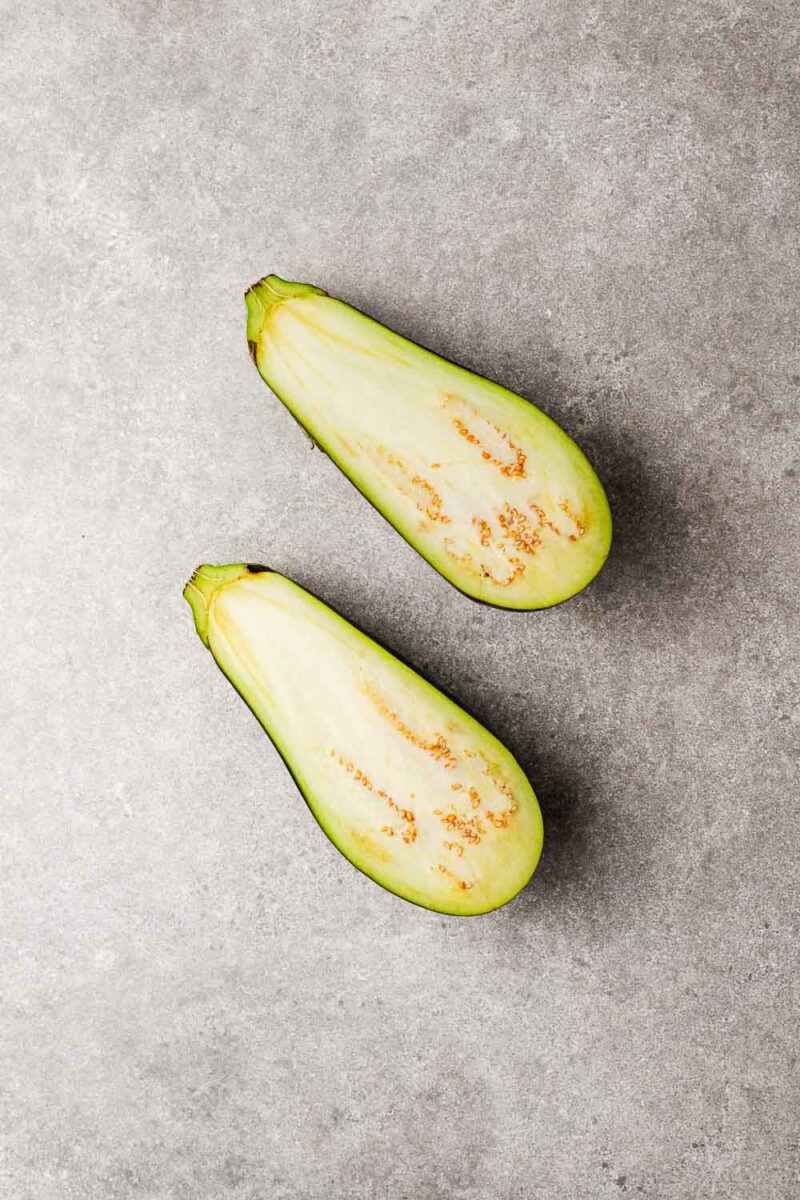
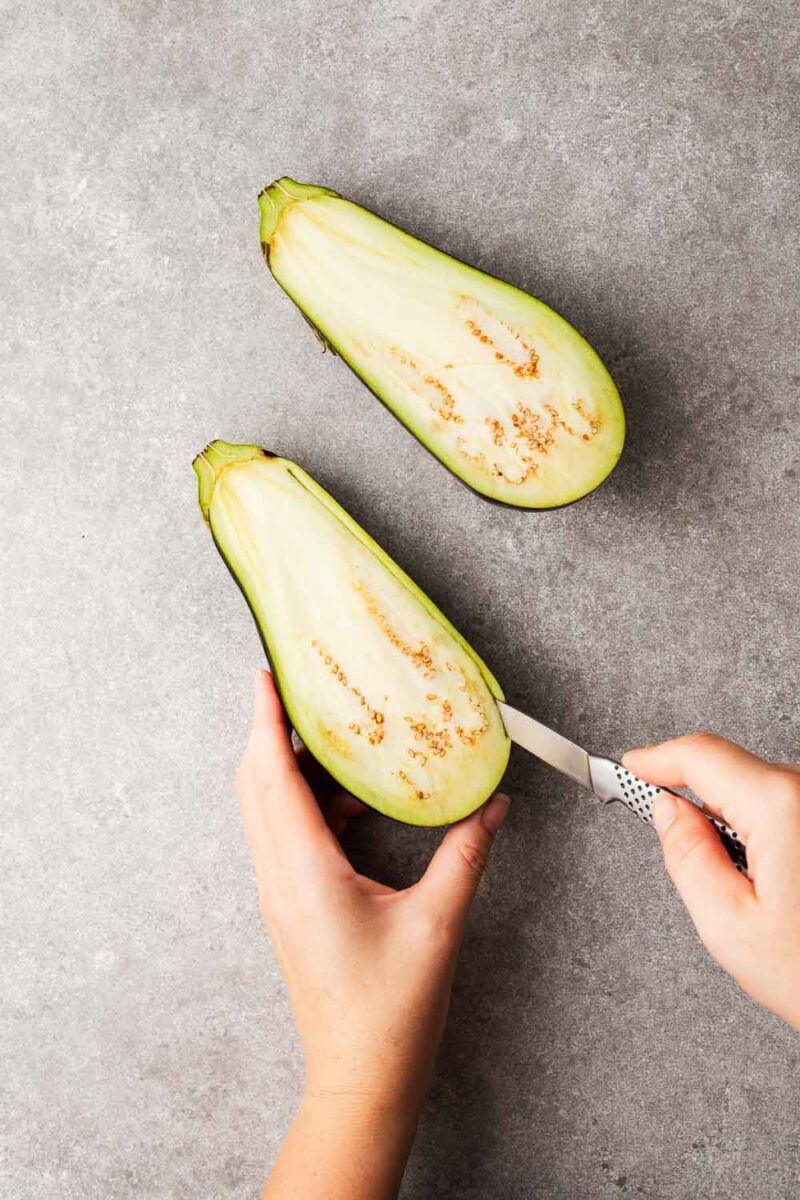
- Cut the eggplant in half lengthwise.
- Use a sharp knife to slice a border around the perimeter of the eggplant flesh without cutting the skin – this will make it easier to eat with chopsticks.
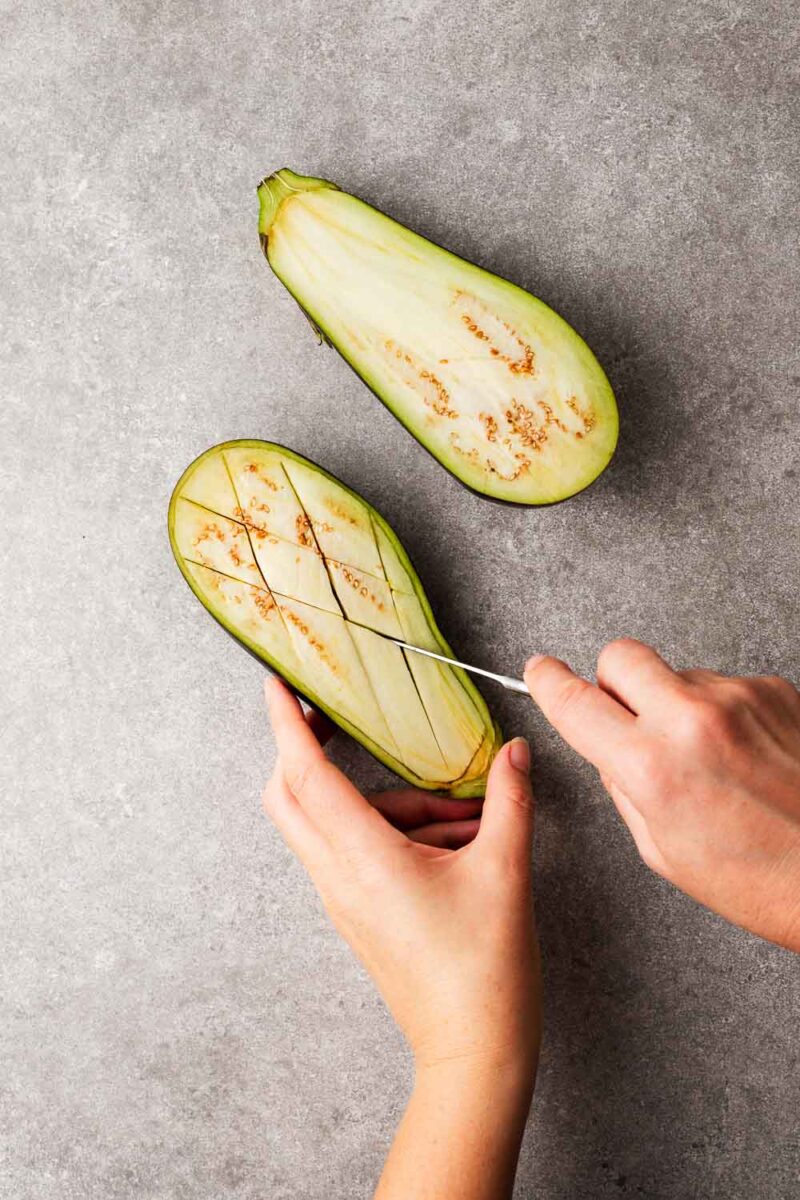
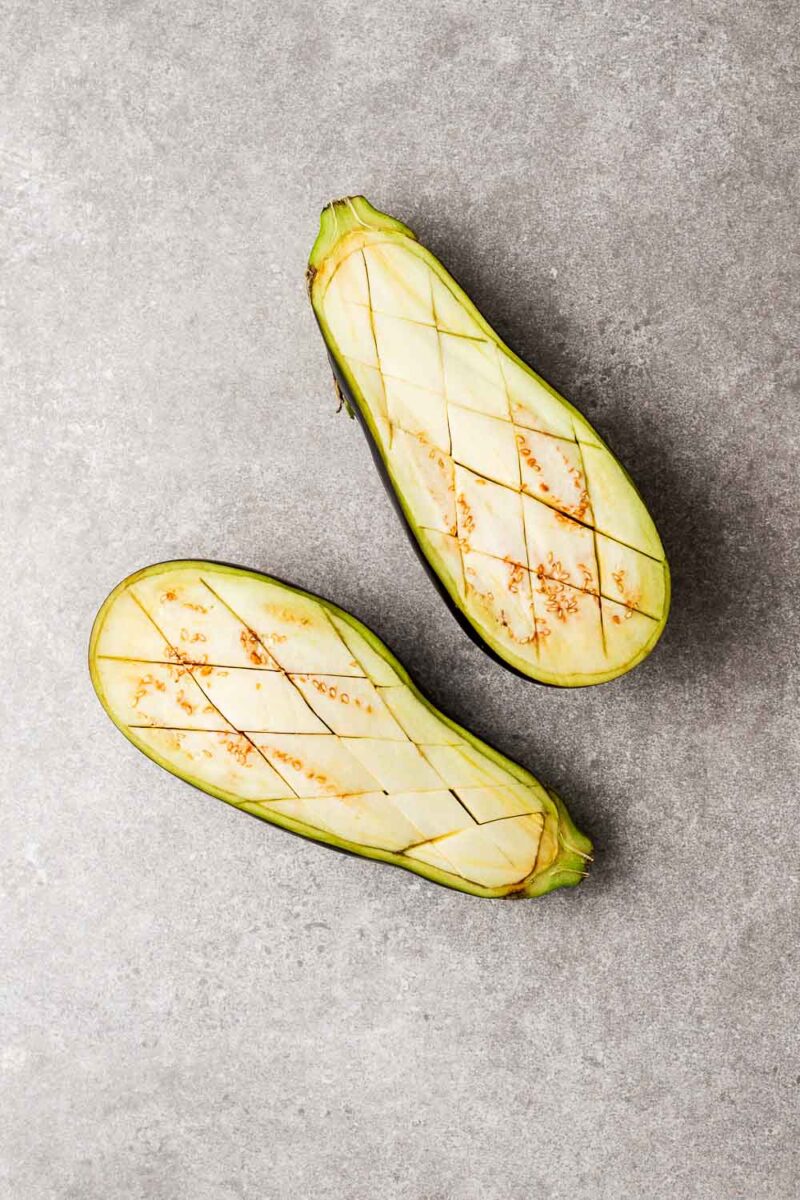
- Next, make three to four parallel cuts in the eggplant flesh, without cutting all the way through to the other side.
- Repeat the slices at an angle to create a criss-cross pattern.
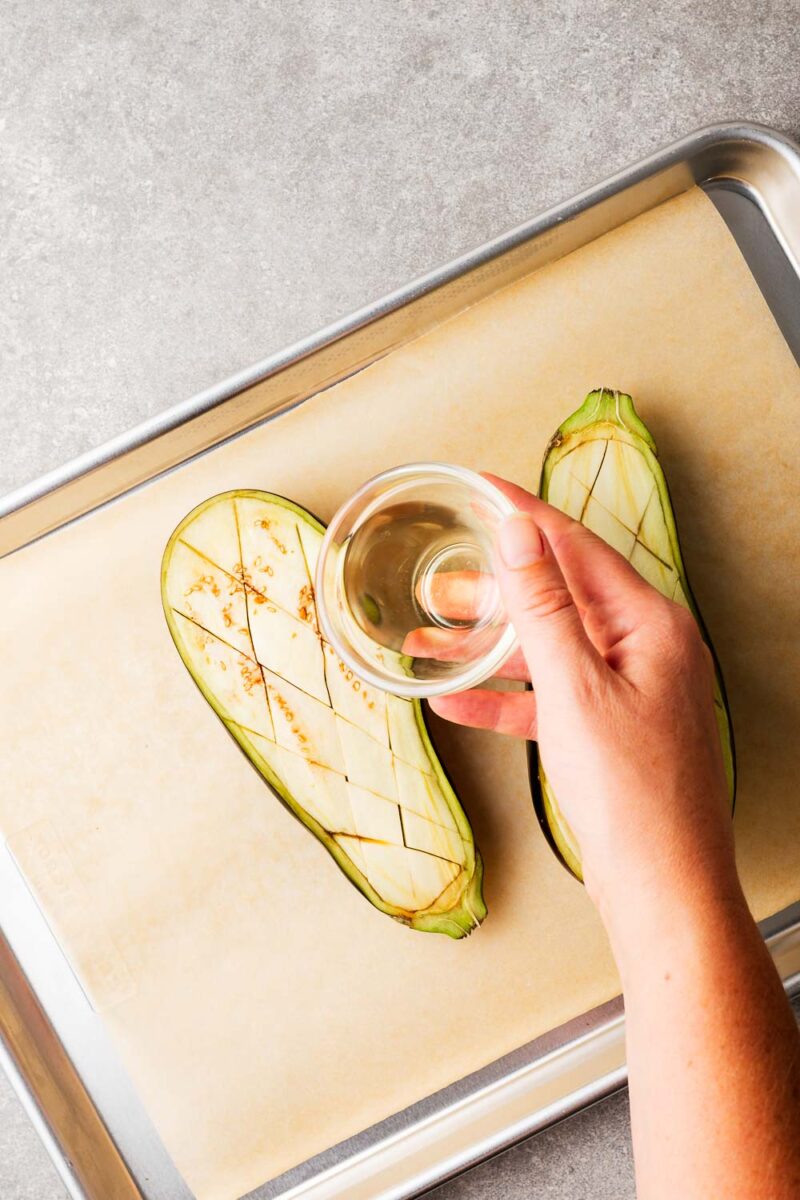
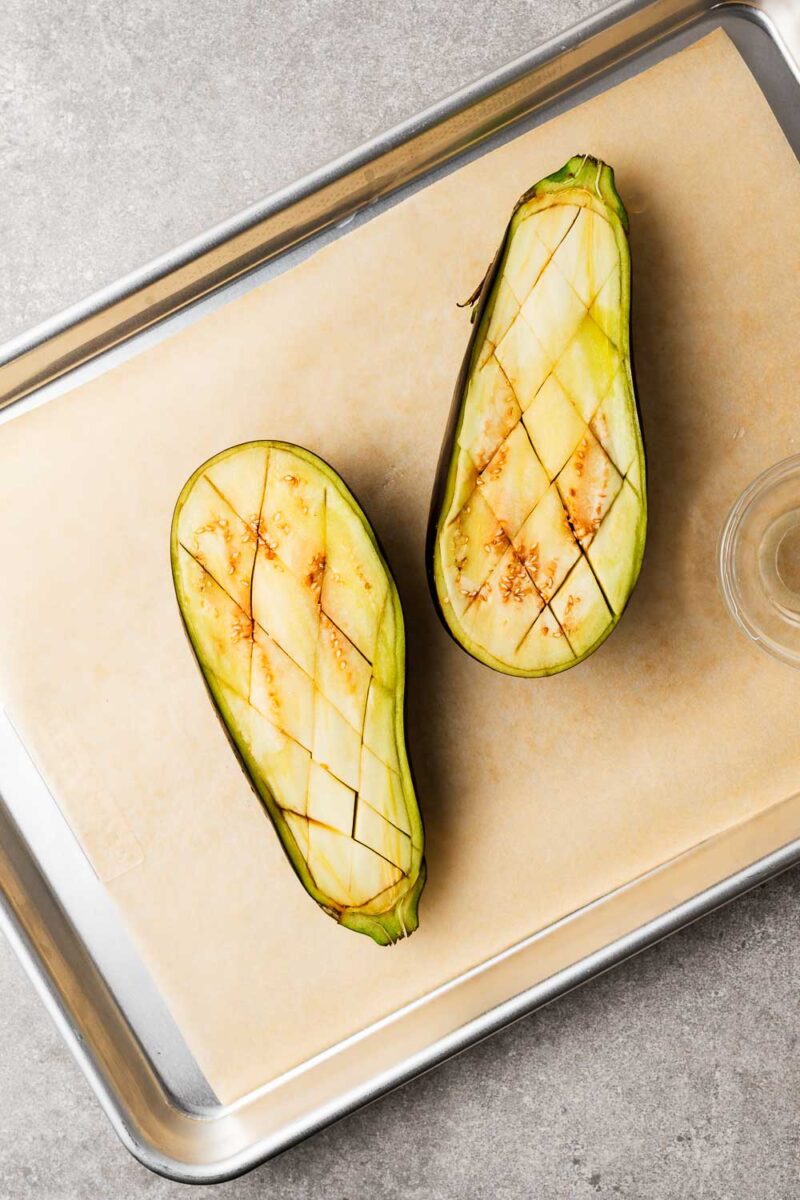
- Generously rub each eggplant slice with vegetable oil, especially the cut side. You’ll need about a tablespoon of oil for a large eggplant.
Cook the prepared eggplant on the stove (Option 1)
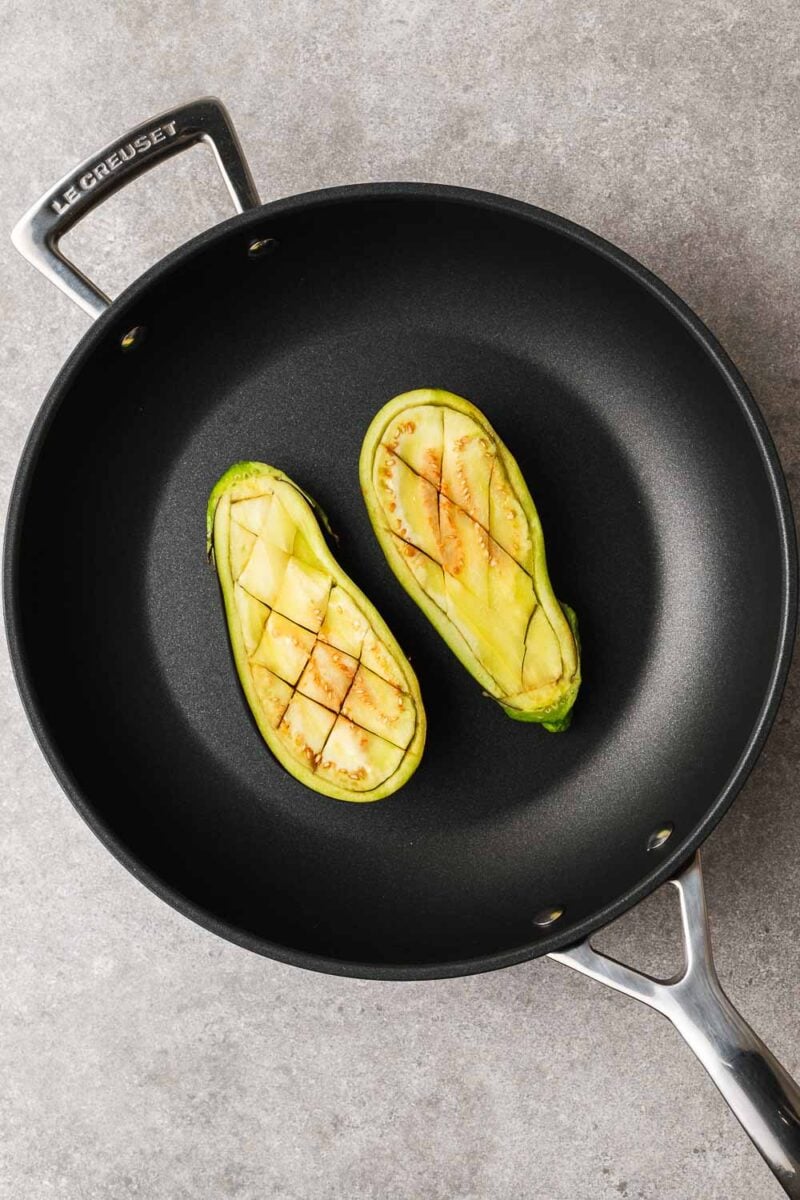
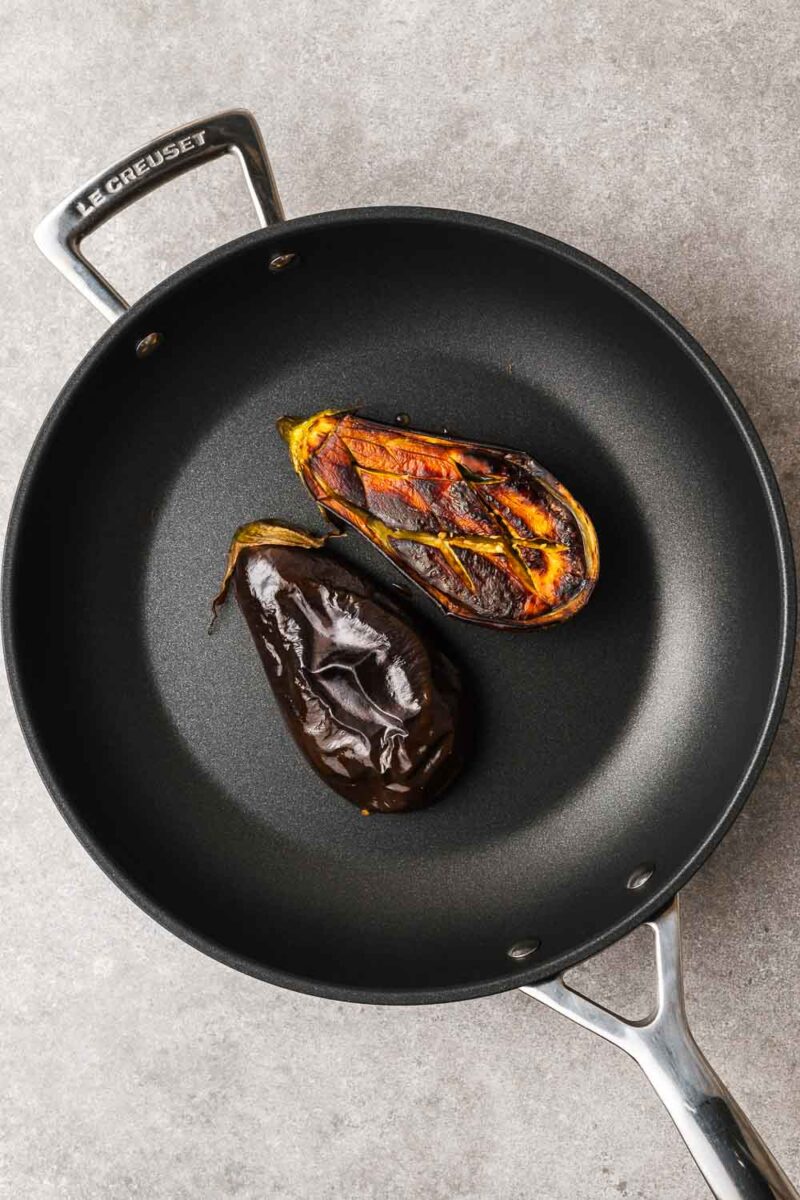
- Heat a large nonstick frying pan over medium heat. Place the oiled eggplant halves skin side down and fry for a few minutes until brown – about three minutes.
- Then, turn the eggplants over, cover with a lid, and fry with the cut side down until they are deep brown and tender – about eight to ten minutes. If they brown too quickly, turn down the heat. They should be golden brown and soft all the way through.
Prepare a sheet pan with parchment paper for when you place the eggplants under the broiler (grill).
Tip: If your frying pan is not nonstick, you’ll need to use more oil.
Add a generous amount of vegetable oil to a frying pan – about ½ inch (1 cm) deep. Heat the oil over medium heat and fry the eggplant until tender and golden – about 5 minutes a side.
After cooking, drain the fried eggplant on a wire rack placed over a plate, cut side down, while the broiler (grill) heats up.
Cook the prepared eggplant in the oven (Option 2)
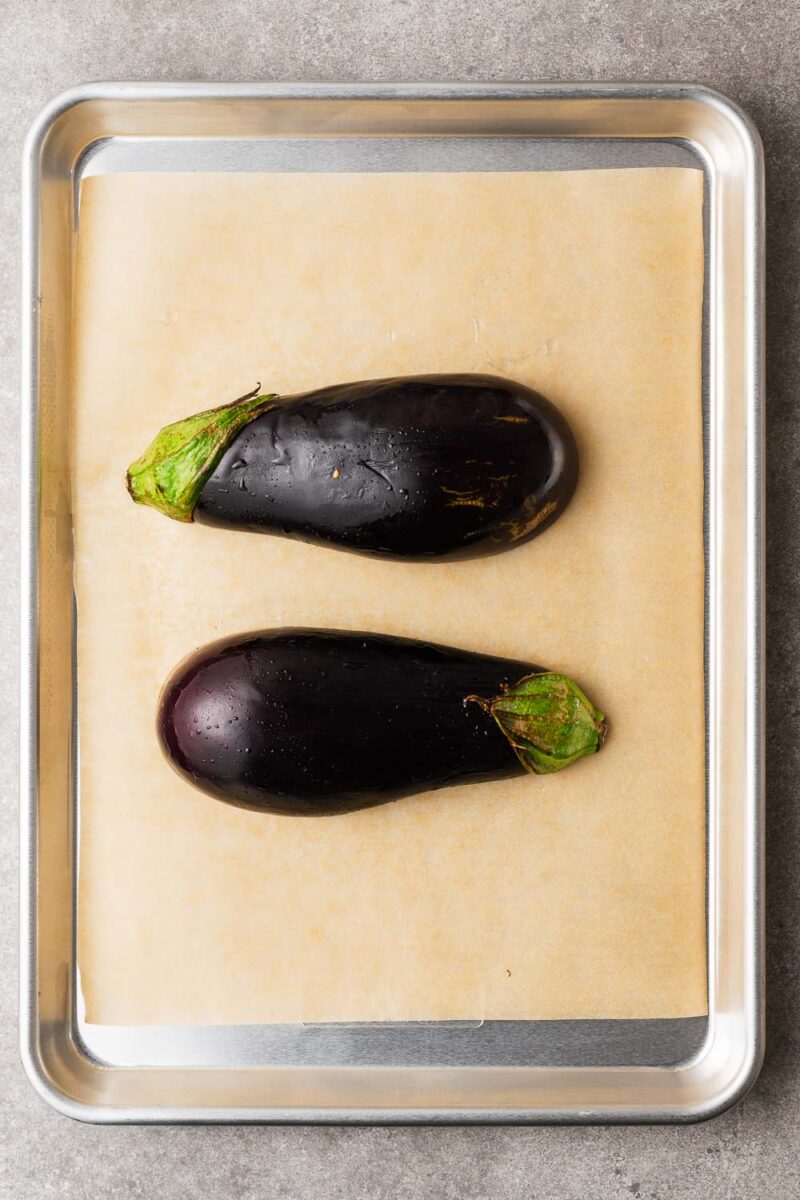
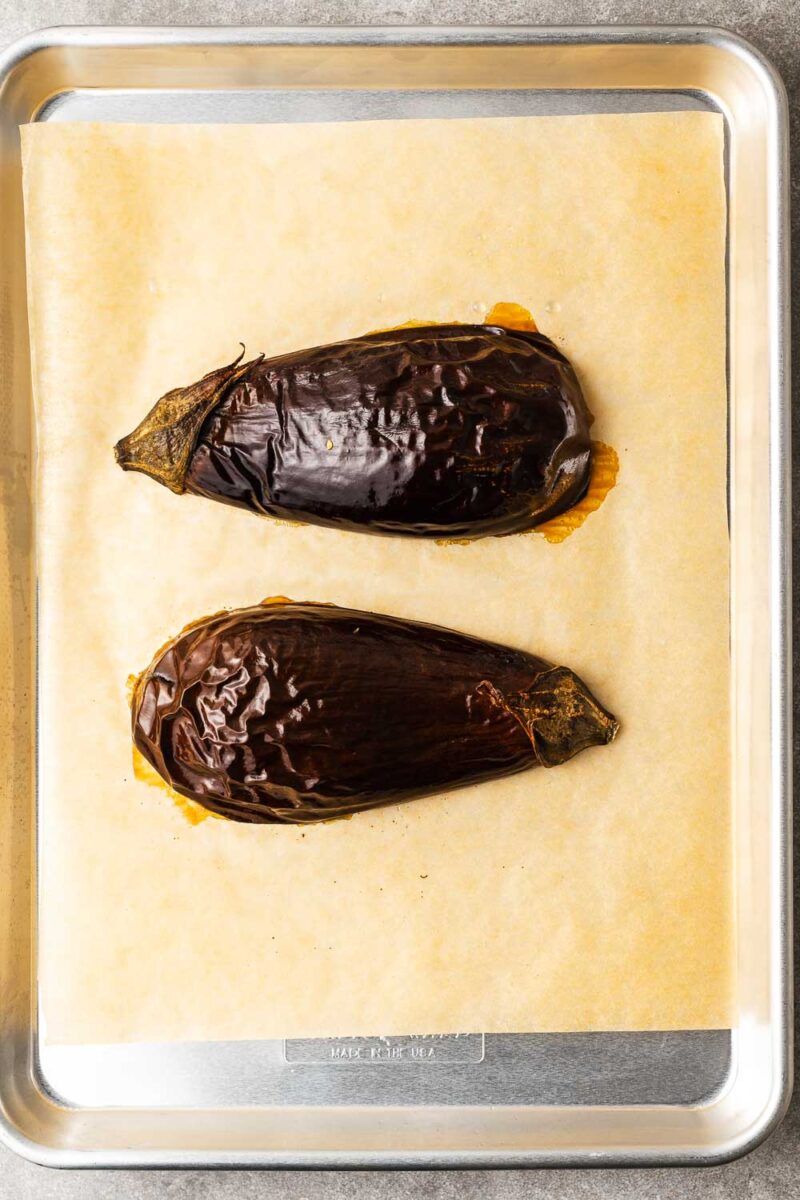
- Line a baking sheet with parchment paper and preheat your oven to 430°F (220°C). Let the baking sheet preheat in the oven for the last five to ten minutes before you add the eggplant.
- Place the eggplant, cut side down, on the preheated baking sheet. Bake for 20 to 25 minutes, or until the eggplants are soft and tender all the way through.
Make the miso sauce
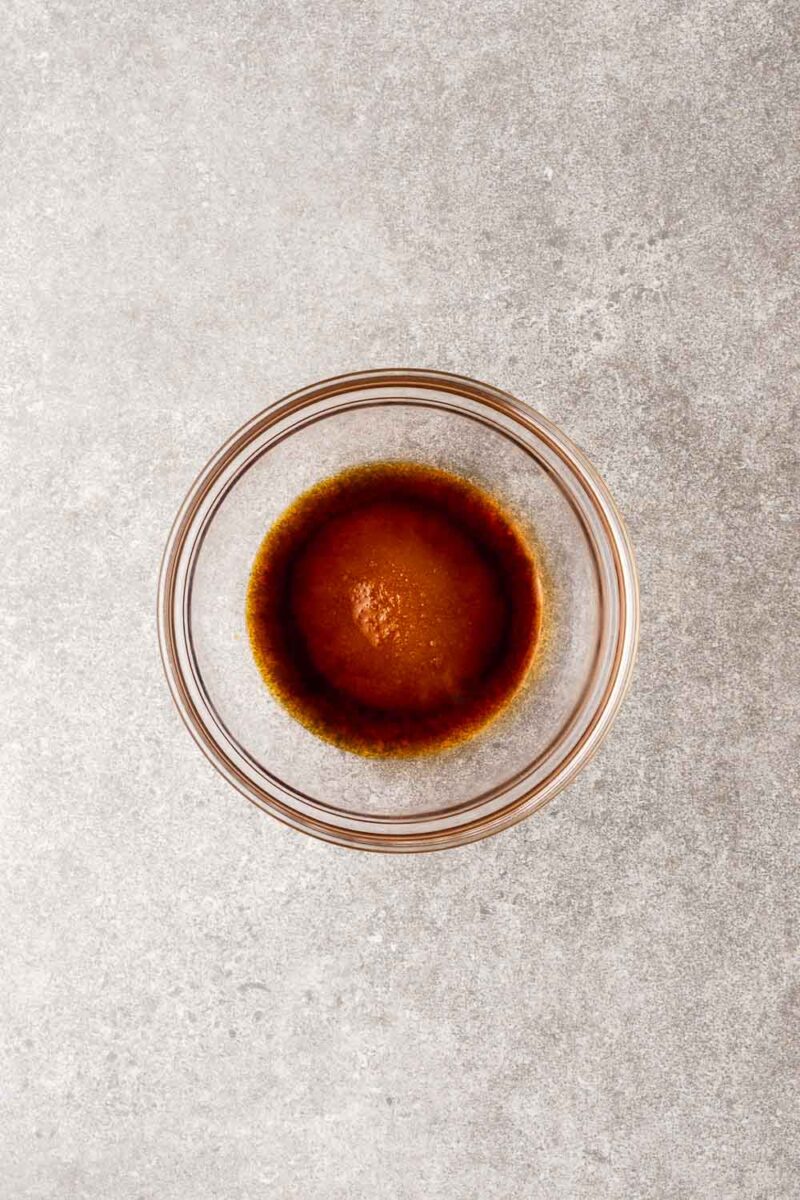
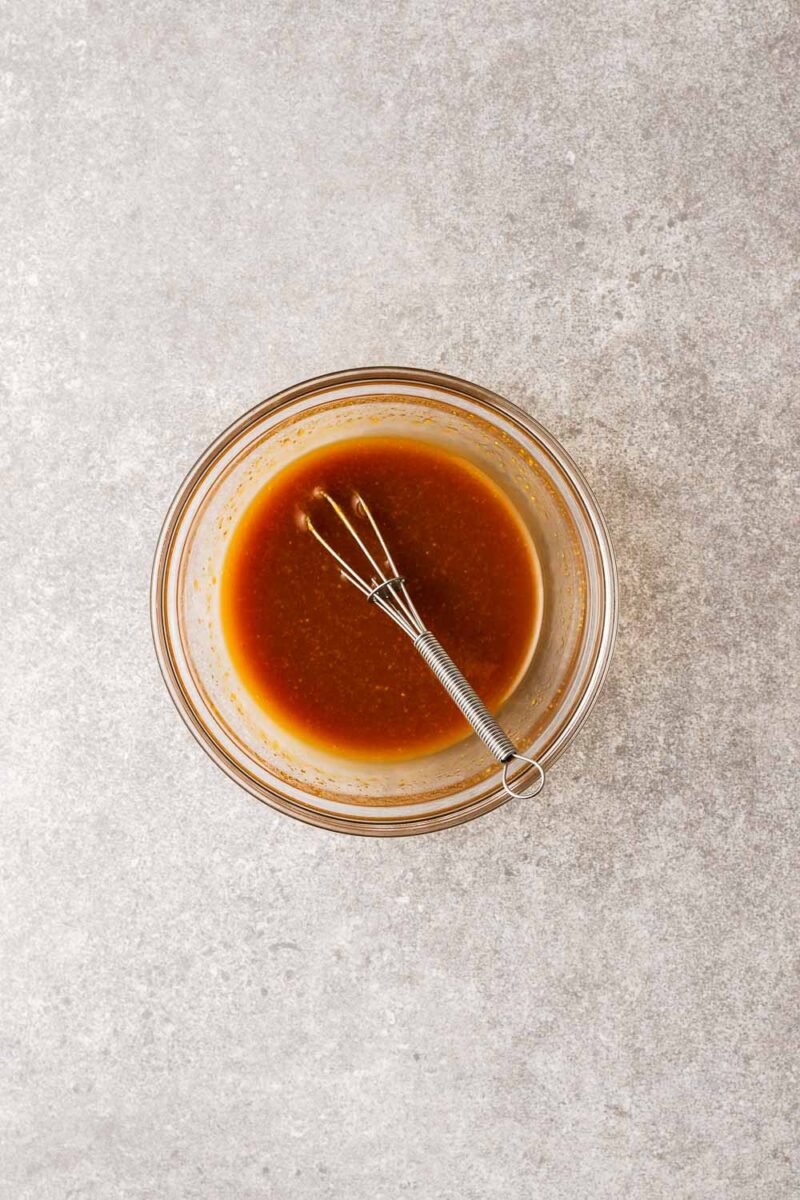
- Stir the soy sauce, mirin and sugar together in a small bowl until the sugar mostly dissolves – you can briefly heat the mixture in a small saucepan if it’s not dissolving.
- Add the miso paste and mix well.
Glaze eggplant with miso sauce
- Heat the broiler (grill element) of your oven. If you don’t have a broiler setting, heat the oven to its maximum temperature and place a rack in the top position.
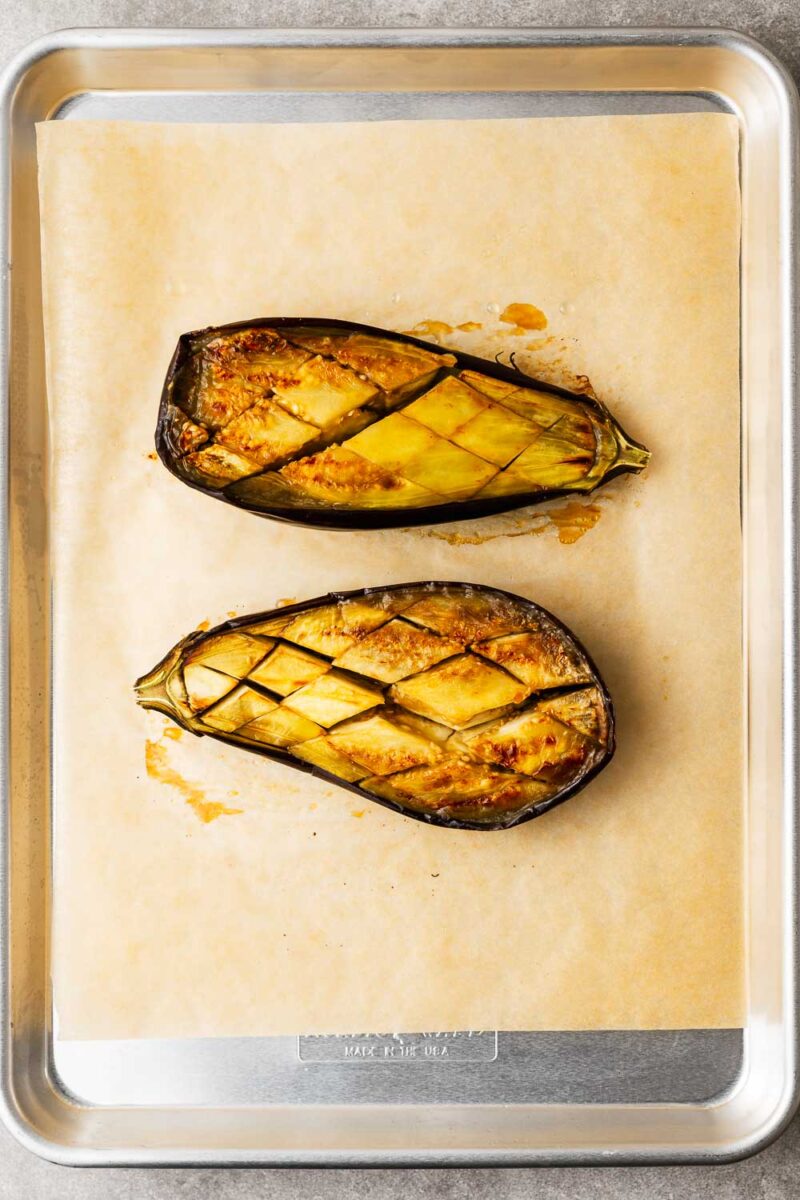
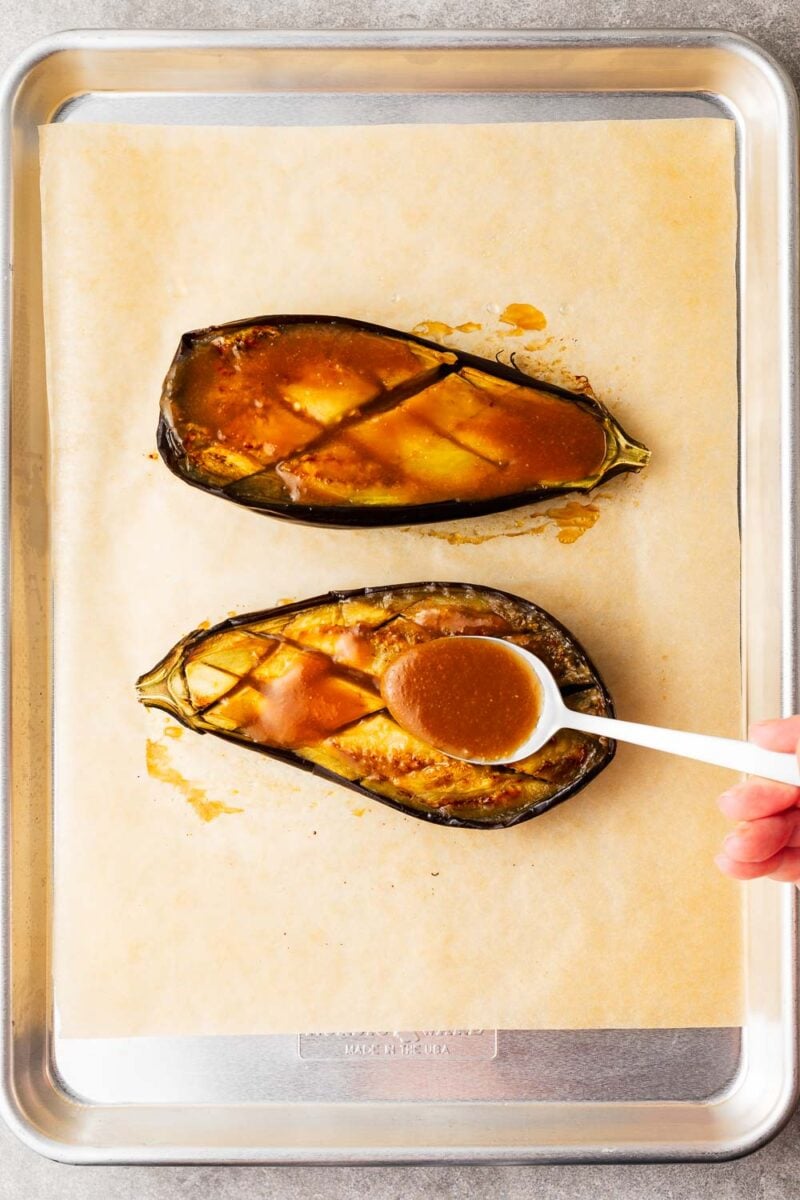
- Place the cooked eggplant cut side up on the parchment-lined sheet pan.
- Use a spoon to spread the miso mixture over the cut surface of each eggplant – about 1½ tablespoons per half.
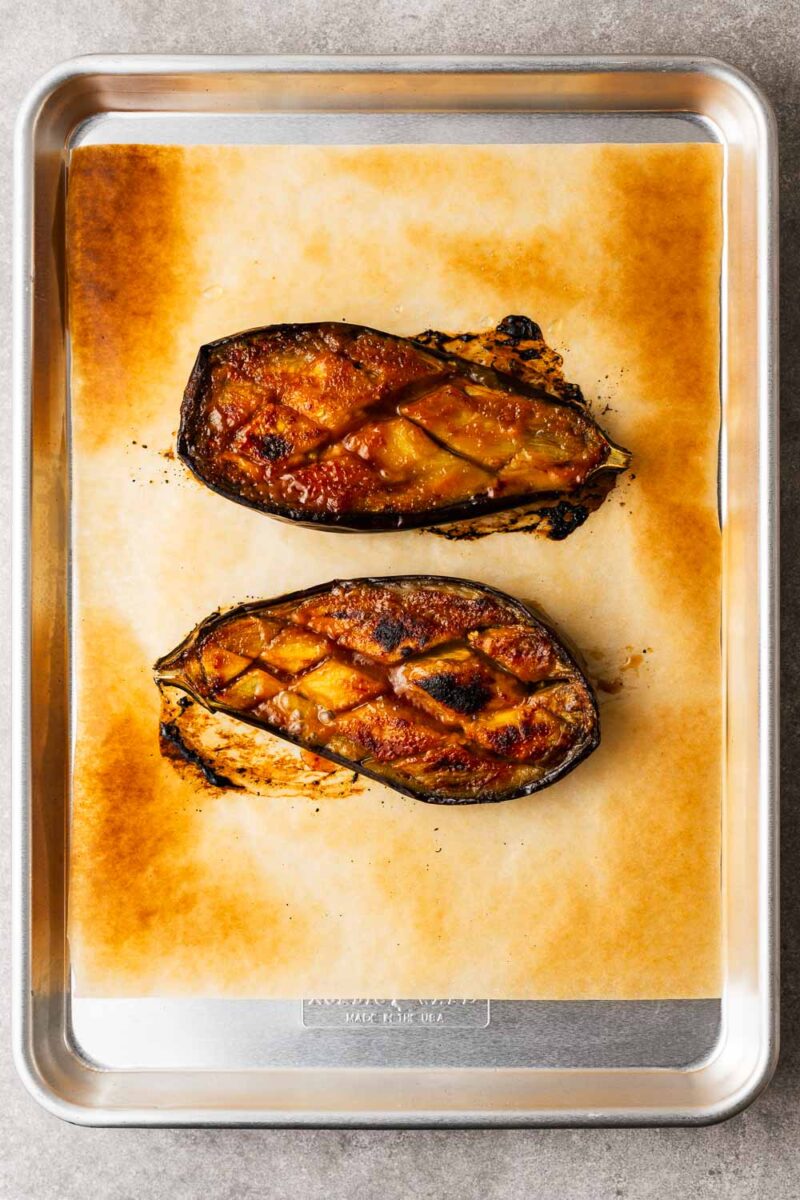
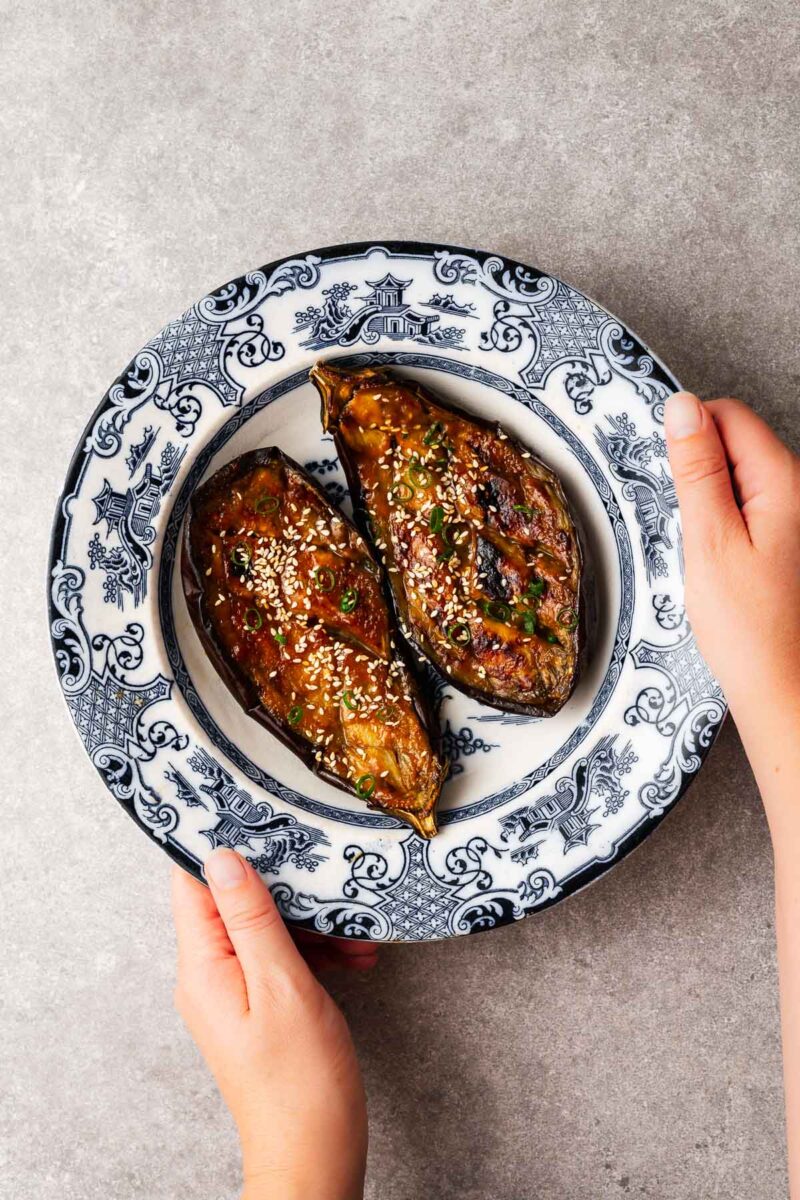
- Place the eggplant under the broiler until the miso sauce is bubbling around the edges and starting to caramelize – about 3 minutes. If you don’t have a broiler, it may take a few minutes longer.
- Remove the eggplant from the oven and transfer it to a serving plate. Serve hot, sprinkled with sesame seeds or thinly sliced green onions. Dig in with a pair of chopsticks to pick out the soft and creamy eggplant cubes from the skin.
Nasu dengaku serving suggestions
Traditionally, dengaku was served as part of temple cuisine but has since become a popular dish in Japanese households and restaurants.
If you have a jar of sweet and savoury miso sauce in the fridge, you can make miso eggplant as a quick and satisfying snack.
But I love to serve it as a main course alongside a bowl of Japanese steamed rice (or fried rice) and fridge-cold silken tofu cubes. The cold tofu creates a wonderful contrast with the sweet, flavourful miso eggplant. You can also add some greens, like stir-fried bok choy, for a balanced meal.
Or use a spoon to scoop out the golden miso-glazed eggplant flesh and stir it into kake udon noodle soup, tsukimi udon, or cold soba noodles for a comforting bowl of sweet and smoky eggplant noodles.
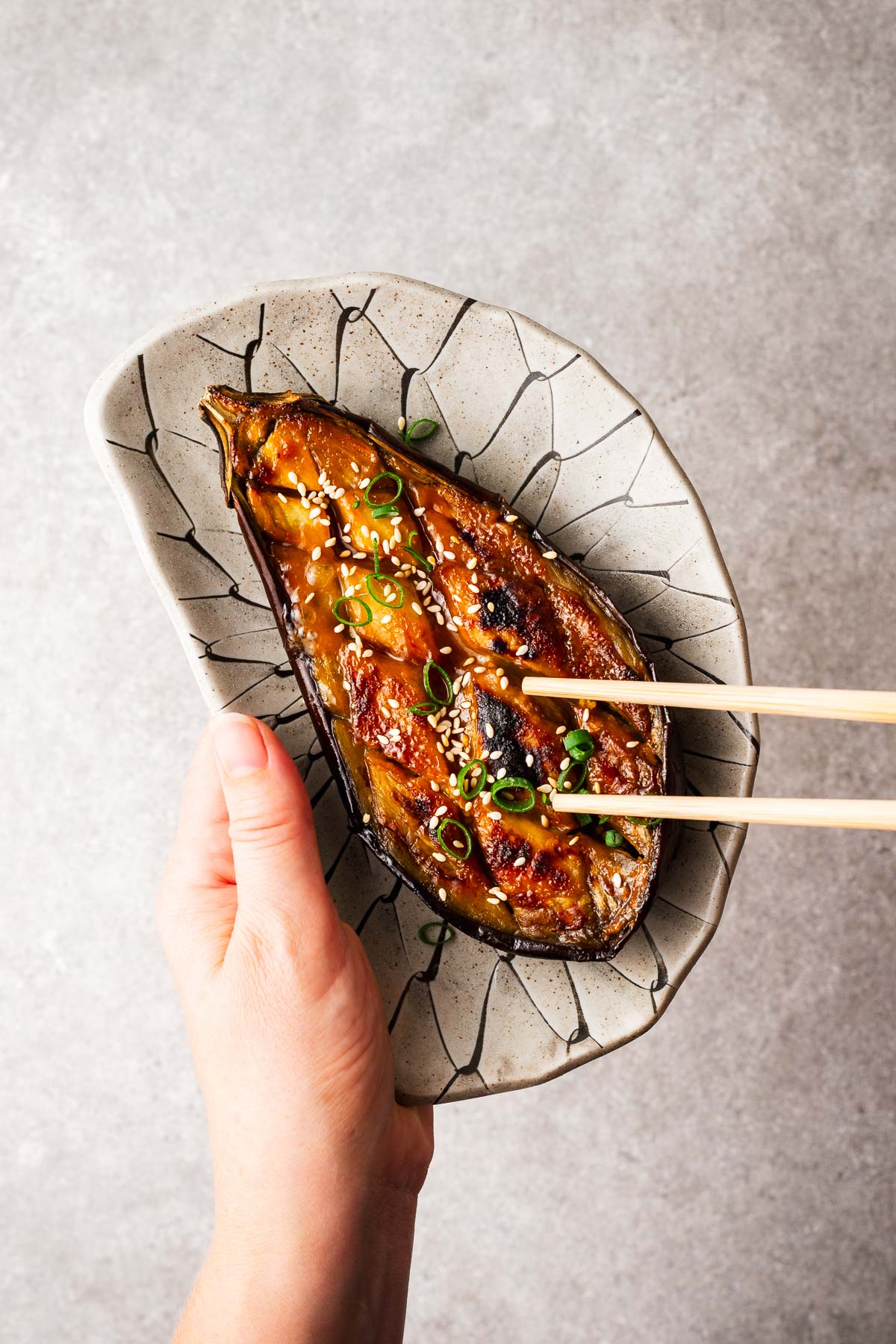
Frequently asked questions
Yes, you can eat the skin of nasu dengaku. The skin becomes soft and tender when grilled or broiled, making it a delicious and nutritious part of the dish. But, if you use very large eggplants, the skin can be tough. In this case, it’s better to scoop the flesh out.
Nasu dengaku has a rich and savoury umami flavour, with a balance of sweet caramelised notes. The creamy texture of the grilled eggplant pairs perfectly with the umami flavours of the sweet miso glaze.
Nasu dengaku is commonly served as a side dish or appetizer in traditional Japanese cuisine. It pairs well with a bowl of Japanese white rice and other grilled or broiled dishes, such as yakitori or teriyaki chicken.
Nasu dengaku originated in Japan and is a popular dish in Japanese cuisine. It is often served in restaurants and at home during special occasions and celebrations.
Miso dengaku refers to the miso glaze used to coat the grilled eggplant in nasu dengaku. The glaze is made from a combination of miso paste, sugar, and sake or mirin, giving it a sweet and savoury flavour. Miso dengaku is also used to glaze tofu skewers and other vegetables.
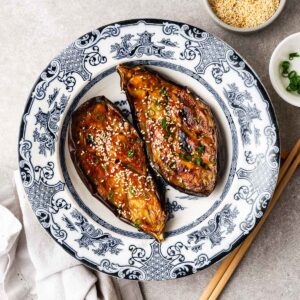
Ingredients
- 1 eggplant* (aubergine)
- 1 tablespoon vegetable oil , or any neutral oil
Miso glaze
- 2 teaspoons sugar
- 1 tablespoon mirin*
- 1 teaspoon soy sauce
- 2 tablespoons miso paste*
Toppings (optional)
- 1 tablespoon toasted sesame seeds
- 1 tablespoon thinly sliced green onion (scallion)
Instructions
- Line a baking sheet with parchment paper.
- If you're using the oven method to cook the eggplant, preheat your oven to 430 °F. Let the baking sheet preheat in the oven for the last 5 to 10 minutes.
- Cut the eggplant in half lengthwise. Use a sharp knife and slice a border around the perimeter of the eggplant flesh without cutting the skin – this makes the eggplant easier to eat with chopsticks. Next, make 3 to 4 parallel cuts in the eggplant flesh. Don’t cut all the way through the skin on the other side. Repeat the slices at an angle to create a criss-cross pattern.
- Generously rub each eggplant slice with vegetable oil, especially the cut side – about a tablespoon of oil in total.
Method 1: Stovetop eggplant
- Heat a nonstick frying pan over medium heat. Place the oiled eggplant halves skin side down and fry for a few minutes until brown – about 3 minutes. Turn the eggplants over, cover with a lid, and fry with cut side down until they are deep brown and tender – about 8 to 10 minutes. Turn down the heat if they brown too quickly. They should be golden brown and soft all the way through.
Method 2: Oven bake eggplant
- Place the eggplant, cut side down, on the preheated baking sheet. Bake for 20 to 25 minutes – or until the eggplants are soft and tender all the way through. Remove the eggplants from the oven and set aside while the broiler (grill) heats up.
- Heat the broiler (grill element) of your oven. If you don’t have a broiler setting, heat the oven to its maximum temperature and place an oven rack in the top position.
- Stir the soy sauce, mirin* and sugar together in a small bowl until the sugar mostly dissolves – you can briefly heat the mixture if it’s not dissolving. Then add the miso paste and mix well.
- Place the eggplant cut side up on the prepared sheet pan. Use a spoon to spread the miso glaze over the cut surface of each eggplant – about 1½ tablespoons per half.
- Place under the broiler (grill) until the miso sauce is bubbling around the edges and starting to caramelise – about 3 minutes. (It’ll take a few minutes longer if you don’t use the broiler.)
- Serve nasu dengaku sprinkled with toasted white sesame seeds or finely chopped green onions. Use chopsticks to pick out the soft and creamy eggplant cubes from the skin.
Notes
- A medium to large eggplant (aubergine) weighing about 12 ounces (350 grams) works perfectly with 1½ tablespoons of miso dengaku sauce per eggplant half. But you can also use Japanese eggplants. Use roughly the same amount in weight, but reduce the cooking time if the eggplants are smaller.
- I use white miso paste for its sweet and fruity flavour, but awase or brown miso also works perfectly.
- I use hon mirin for this recipe (sweet Japanese rice wine). If your mirin has ingredients like sugar or corn syrup, it’s not “real brewed mirin” and is likely much sweeter. Go ahead and use it, but reduce or omit the sugar – otherwise, your sauce will be crazy sweet. Alternatively, substitute the 1 tablespoon mirin for 1 tablespoon of drinking sake and an extra teaspoon of sugar (or maple syrup). See the ingredients and substitutes for more information.
- This miso eggplant recipe also works well with all-purpose miso sauce. Use 1½ tablespoons of miso sauce for each half eggplant.
- Which method to use? The stovetop method is quick but more hands-on, and the resulting eggplant has an extra silky texture. But you can easily burn the eggplant if you don’t keep an eye on it. The oven method is hands-off and more forgiving, but it takes a bit longer.
More Japanese Recipes
- Miso scrambled eggs
- Zaru soba (Cold soba noodles with dipping sauce)
- Homemade mentsuyu (Japanese noodle soup base)
- Easy avocado sushi rolls
- Kake udon noodle soup
- Tsukimi udon noodle soup

I never knew eggplant could be this good! The texture is silky and the sauce has everything umami I love about miso paste, with the touch of sweetness it’s so good.
I know, right? This eggplant is utterly moreish… Sometimes I feel like having it for dessert!
I’m so happy you enjoyed the recipe, thank you for popping in!